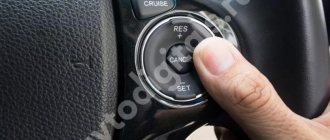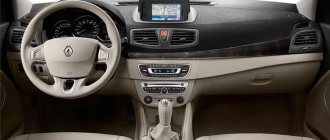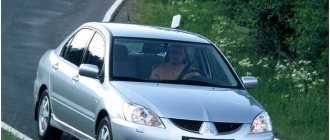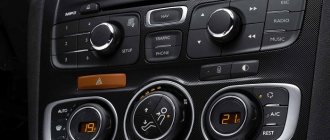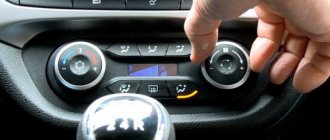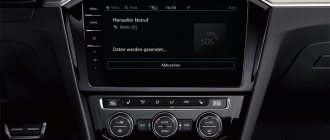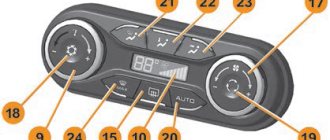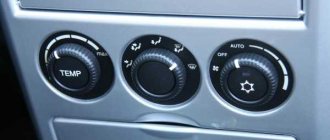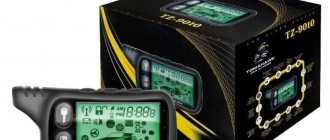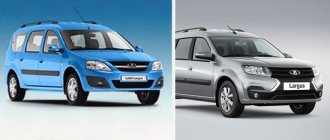How is cruise control different from adaptive cruise control?
What is cruise control? Unfortunately, many car owners know about this function only superficially. What is adaptive cruise control? We think, friends, that not many drivers will be able to answer this question in detail and in detail, despite the fact that this technology has long appeared in the automotive industry. Let's find out together today in more detail what this useful and, at the same time, very amazing function (option) in modern cars is.
So, dear drivers, what is cruise control? Cruise control is an electronic system that automatically regulates vehicle speed without driver intervention. That is, the cruise control system allows the driver to take his foot off the gas pedal while driving the car. This is the simplest explanation that, in principle, fits the basic description of the classic cruise control system. But these days, many automakers are adding more and more advanced cruise control systems to their cars every year, which make the process of driving much easier and safer.
Also, many modern cruise control systems have now become an intermediate stage in the transition of the entire automotive industry to the full autonomy of a modern car, which in the future, according to experts, will be able to completely operate without a driver.
See also: The most popular options in cars in 2016
When this cruise control was the preserve of only high-luxury cars. Some 20 years ago it was impossible to know what cruise control was; only the owner of an expensive luxury car could find out. Today, when the cost of this technology has dropped significantly and significantly, automakers have begun to equip even economy-class cars with cruise control.
Today we can get such cruise control for ourselves even in the cheapest and least prestigious small cars. Just 10 years ago this seemed like a fantasy to many.
What else can he do?
It is worth touching on the additional features that cruise control provides. In addition to determining the distance between cars, calculated from the delay time of the reflected signal, the system is able to determine the speed of the car ahead, for which a change in the frequency of the reflected signal is used according to the Doppler effect.
Dynamic control - monitoring the movement parameters of the car ahead, is supplemented by monitoring its position on the road, i.e. the location of the front car relative to the rear one on the road.
What is adaptive cruise control (ACC)?
The main difference between classic cruise control and modern systems for automatically maintaining a given vehicle speed is the electronic ACC system, which in principle itself means adaptive cruise control. These systems allow the car to independently maintain, without driver intervention, not only a certain speed on the road, but also maintain it in accordance with road traffic, working automatically, i.e. reduce speed if there is a danger of a collision between the car and other vehicles.
Also, certain high-end cars take these adaptive cruise control technologies even further. For example, some automakers equip their products with semi-automatic autopilot, which is activated when the adaptive cruise control option is activated. As a result, we get the following: the car not only automatically maintains its speed and monitors the distance between other vehicles on the road, but also autonomously controls the car itself (for example, it smoothly turns or maintains the car’s course in the lane).
On what machines does it fit?
Today it is difficult to give a list of cars with adaptive cruise control, because it will be huge. Almost all modern manufacturers try to install such systems on their machines and even come up with their own names. The system is installed on a number of models of Mercedes-Benz, Porsche, Bentley, Toyota, Lexus, Subaru, Volkswagen, Hyundai, Infiniti and others.
You can figure out which cars have adaptive cruise control using a filter on car sales sites. Also, this point must be clarified with the dealer when purchasing a vehicle, because a lot depends on the configuration.
History of cruise control.
The history of the cruise control system goes back to the 17th and 18th centuries, when engineers invented a speed control system for steam engines. These mechanical systems were subsequently adapted into the first automobile models (certain models) at the beginning of the 20th century. But in reality, cruise control, as we understand it, appeared only after the 1940s.
The first car equipped with cruise control was the 1958 Imperial, which was produced by the luxury division. The system was called "Autopilot" and was a conventional mechanical solution. It looked like this: -the dashboard was equipped with a mechanical disk on which the speed scale was printed. The driver, who was about to turn on the mechanical cruise control, had to select the desired speed on a round dial and turn the dial, which was connected to the driveshaft. Also, with the rotation of the speed selection dial, the electric motor was simultaneously turned on, which automatically adjusted the position of the throttle valve on the engine, thereby maintaining the required vehicle speed.
In 1965, American released a budget version of the cruise control system for its car models. But then, during the oil crisis in 1973, interest in the cruise control system suddenly disappeared. But starting from the late 80s, the popularity of this cruise control began to grow rapidly. Ultimately, most modern cars today can be equipped with cruise control.
Initially, this popularity of cruise control was observed in the United States. This was specifically due to the fact that in America traditionally and most of all people love cars with automatic transmissions, they love long trips throughout the country due to the huge network of expressways.
For example, the popularity of cruise control came to Europe much later, in comparison with the same United States of America.
But nevertheless, in Europe as in the USA, cruise control initially appeared only on luxury cars, and then this cruise control system began its journey and gradually began to spread to ordinary cars.
See also: How to keep your modern car clean so it can “see” in winter
But the first adaptive cruise control (ACC) appeared only in the early 1990s in Japan. Although the first generation of adaptive cruise control systems merely warned drivers of danger and advised them to reduce speed by pressing the brake pedal while the cruise control was on.
Only a few years later, adaptive cruise control systems began to appear in the auto industry, which autonomously regulated not only one throttle valve, but also the brakes of the car itself.
The first full-fledged cruise control appeared on a Mercedes S-Class in 1999, which was called “Distronic”. This system not only controlled the throttle, but was also able to control the brakes, maintaining the car's predetermined distance from the vehicle in front.
Since then, time has passed and automakers have begun to widely use adaptive cruise control (ACC). Ultimately, this ACC system today can be found on all cars without exception, from mini cars and hatchbacks to crossovers and sports cars.
It is worth noting here that due to the increase in car traffic on the roads of the whole world, this adaptive cruise control has become more useful (useful function) for many cars, in comparison with standard cruise, since its adaptive option allows the car not only to maintain the speed set by the driver , but automatically maintain a safe distance from vehicles ahead.
How does cruise control work?
Modern cruise control systems are integrated into the vehicle's electronics and are often installed on vehicles in combination with additional technologies. For example, with an intersection and lane warning system, with a blind spot monitoring system, or with an emergency emergency braking system in case of danger on the road.
With a standard cruise control system, to maintain speed, the driver must use a switch to set the desired speed and then press either a button on the steering wheel or a lever on the steering column. As a result, the car’s electronics will simply remember the set speed and automatically begin to maintain the set speed of the car using throttle control.
On some cars you can adjust the speed using a button and then the car will automatically change its speed.
On a vehicle equipped with adaptive cruise control (ACC), you can increase or decrease the set speed while the vehicle is moving, and the vehicle will automatically accelerate or decelerate to the set speed.
Also, this adaptive cruise control system uses radar or laser sensors to maintain a set distance from the vehicle ahead. Also, using these same sensors, this adaptive system can both increase and decrease the distance to vehicles in front as needed.
See also: Top 10 future car technologies
To disengage cruise control, simply press a button and you will regain control of the throttle using the gas pedal. It is worth immediately noting the main feature of all types of cruise control, namely, when you press the brake pedal, the speed control system automatically turns off. This is done primarily for safety.
On vehicles with a manual transmission, pressing the clutch pedal also deactivates the cruise control for safety reasons. True, not all modern cars behave this way. It all depends on the make and model of the car.
By the way, friends, most cars equipped with such cruise control systems have a memory function. This means that by setting a certain speed to keep the car moving on the road, this speed setting will subsequently remain in the system memory and you will not have to set this speed again. This also happens (applies) if the cruise control is turned off due to pressing the gas or clutch pedal.
We also draw your attention to the following: on earlier cruise control systems, the system is activated only at a speed of at least 30 - 50 km/h. It is also worth noting here that some automakers still stubbornly support such a speed limit.
However, in most modern cars these days, this cruise control can be turned on when the car is moving, even at its minimum speed. This is done primarily so that modern adaptive cruise control can work (interact) together with the start/stop system, which automatically turns off the engine when the car stops.
Main elements of the system
A modern ACC assistant consists of the following parts:
- sensors, thanks to which the speed of passing cars and the distance between moving cars are determined. The range of action of such devices is completely different - from 40 to 200 meters. They are usually mounted on the front bumper or radiator grille, and the operating principle is based on working with ultrasonic or laser waves;
- The ACC control unit itself, which receives these waves, processes them, and also checks them with the parameters that the driver has set for the car. This unit is able to accurately determine the distance to the car in front, calculate its speed, analyze the data obtained and compare it with the driving mode of your car, give recommendations on speeding up or braking;
- additional equipment or software that transmits commands to other systems of the car - braking, directional stability, throttle, etc.
Types of cruise control systems.
There are four types of cruise control, namely, from the simplest system, which can only maintain a set speed, to a more complex system, which can automatically change the vehicle's lane. Let's look at the advantages and disadvantages of these types of cruise control systems.
Speed limiter.
What it is? This system in the car acts as a conventional maximum speed limiter. For example, in some countries, many commercial vehicles have a speed limit of 110 km/h. The car, when reaching the limited maximum speed, simply stops accelerating. As a rule, such a system does not warn the driver when the limited speed is reached. Such a restriction can be set either by the driver himself or by the owner of this vehicle, who, for example, runs a business in the field of commercial transportation and does not want his drivers to exceed a certain speed limit on the road.
See also: Catalog of icons on the car dashboard
In which car brands is it found: Citroen, Ford, Nissan, Peugeot, Renault. Also, this speed limit system can be installed on any used commercial vehicle.
Advantages: Helps you (the driver) adhere to the speed limit, allows you to save fuel and not violate traffic rules.
Disadvantages: The driver must continue to use the throttle to maintain speed (keep their foot on the gas pedal).
Cruise control.
What it is? Standard cruise control is a fairly common system in many modern new cars, including the same system (usually when cruise control is activated, a speed selection scale and a corresponding system icon appear on the dashboard) where the driver first selects the speed of the car. and then fixes it, and then the car begins to maintain the speed set to it without the driver’s participation. That is, you can safely take your foot off the gas pedal and the car will continue to move at the given speed. But regular cruise control cannot maintain a safe distance from other vehicles, so the driver must press the brake pedal independently to avoid a collision.
What makes of car is found in: Most new cars these days are equipped with cruise control.
Benefits: Helps relieve stress and fatigue of the driver during long trips. Fuel economy.
Disadvantages: The driver must control the distance on the road and, if necessary, reduce the speed of the car. Also, this conventional cruise control can be used mainly only on highways or autobahns with heavy traffic.
Adaptive cruise control.
What it is? This system, working using radar or laser, can not only maintain the speed set by the driver, but also automatically control the distance to vehicles in front and, if necessary, reduce speed to avoid getting too close to other vehicles.
With adaptive cruise control turned on, the driver can independently use the brake pedal at any time.
In what brands is it found: BMW, Fiat, Ford, JLR, Lexus, Mercedes, on VW Group models, as well as on a number of other automakers.
Advantages: The system regulates the speed of the car depending on the traffic on the road and independently decides on a safe distance, automatically pressing the brake pedal and not only if necessary, which contributes to significant fuel savings.
Disadvantages: Unfortunately, the adaptive cruise control sensors are not yet perfect and can simply be “blinded” (not see obstacles on the road) in bad weather. Also, the electronics themselves may not work efficiently enough. For example, a car may be delayed in reacting to a sudden slowdown in traffic. Therefore, when adaptive cruise control is turned on, the distance to the car in front must be quite large (decent), and the speed of the car must correspond to the general flow of cars, otherwise your car may not have time to brake in time in the event of a sharp braking of this stream of cars in front of you. As a result of all this, drivers who turn on adaptive cruise control often encounter such a problem when their car accelerates or reduces speed not smoothly, but with some vague jerks, which creates discomfort for them.
Operating principles of the ACC system
In accordance with generally accepted standards, all car manufacturers configure the operation of this assistant in such a way that it can begin its action at a speed of at least 30 km/h, and the limit value is 180-200 km/h. Activation of the service is carried out using special buttons or selectors, which, most often, are displayed on the steering wheel of the car. Switching on is done using the On/Off or Set key, and switching off occurs immediately after pressing the brake or clutch pedal. Speed limits are set for the car using the Set button, and the “+” or “-” keys allow you to increase or decrease the speed limit.
